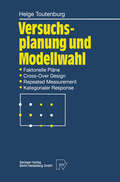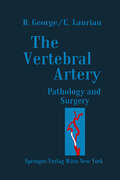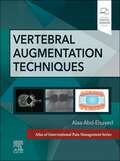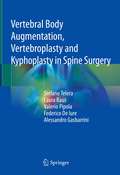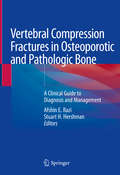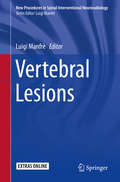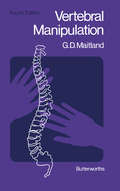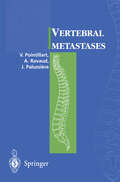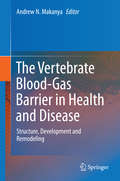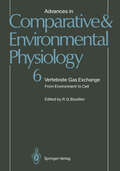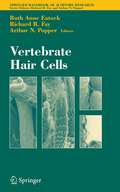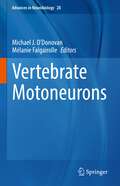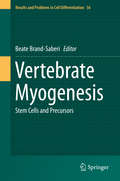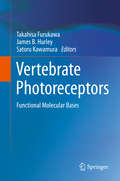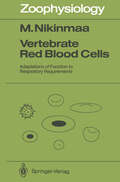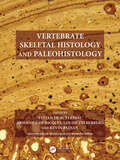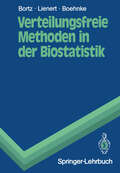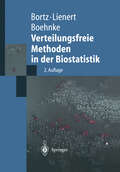- Table View
- List View
Versuche zur Verbesserung der Operationserfolge bei Verpflanzung der Harnleiter in den Darm. Die „Verlagerung“ der Harnleiter in den Darm: Habilitationsarbeiten Vorgelegt der Medizinischen Fakultät Würzburg zur Erlangung der Venia Legendi für das Fach der Chirurgie
by Carl ReimersDieser Buchtitel ist Teil des Digitalisierungsprojekts Springer Book Archives mit Publikationen, die seit den Anfängen des Verlags von 1842 erschienen sind. Der Verlag stellt mit diesem Archiv Quellen für die historische wie auch die disziplingeschichtliche Forschung zur Verfügung, die jeweils im historischen Kontext betrachtet werden müssen. Dieser Titel erschien in der Zeit vor 1945 und wird daher in seiner zeittypischen politisch-ideologischen Ausrichtung vom Verlag nicht beworben.
Versuchsplanung und Modellwahl: Statistische Planung und Auswertung von Experimenten mit stetigem oder kategorialem Response
by Helge ToutenburgThe Vertebral Artery: Pathology and Surgery
by Bernard George Claude LaurianOur common interest in surgery of the vertebral artery was born in 1976, when as residents in the same hospital, we attended an attempt by two senior surgeons to treat an aneurysm of the vertebral artery at the C 3 level. Long discussions had preceded this unsuccessful trial, to decide if surgery was indicated and to choose the surgical route. Finally a direct lateral approach was performed, but access was difficult and correct treatment was impossible, resulting in only partial reduction of the aneurysmal pouch. Following this experience, we decided to seek a regular and well defined approach for exposition of the vertebral artery. Review of the literature indicated some surgical attempts, but the descriptions did not give the impression of safety and reproducibility. No landmark on the described surgical route appeared sufficiently reliable. Henry's anatomical work (1917) gave the only accurate description on vertebral artery anatomy, and it became the basis for our work. When the same patient was referred again one year later, after a new stroke in the vertebro-basilar system, we had behind us repetitive experience on cadavers of an original approach to the distal vertebral artery.
Vertebral Augmentation Techniques: Vertebral Augmentation Techniques - E-Book (Atlas of Interventional Pain Management)
by Alaa Abd-ElsayedVertebral Augmentation Techniques, part of the Atlas of Interventional Pain Management series, is a concise, practical guide that provides clinicians with detailed, step-by-step guidance on how to perform the latest interventional techniques for treating patients with chronic pain as a result of vertebral fractures or osteoporosis. This comprehensive, easy-to-follow guide offers expert coverage of how to deliver safe, accurate, and cost-effective pain relief to patients using all clinically useful imaging modalities, including ultrasound-guided techniques and fluoroscopy. With high-quality images and clear, authoritative guidance throughout, it shows exactly how to evaluate the causes of pain, identify the most promising stimulation technique, locate the site with precision, and deliver effective relief. Offers a comprehensive overview of the latest techniques used in vertebral augmentation. Features clinically relevant anatomic drawings and radiologic images that provide step-by-step instruction on techniques. Provides clear guidance on the risks and benefits, as well as indications and contraindications, for each procedure. Covers key topics such as Vertebroplasty/Kyphoplasty: Transpedicular Approach; Balloon Augmentation; Vertebral Augmentation with Osteotome; Vertebral Augmentation Using Expandable Intravertebral Implants; Basivertebral Nerve Ablation; and more. Includes easy-to-follow, templated content on patient selection, preoperative prep, and post-operative care. Contains full-color line drawings, photographs, and ultrasound images that provide you with a firm grasp of the anatomy and equipment involved with each procedure. Highlights potential pitfalls for each technique and offers clinical pearls on how to avoid them.
Vertebral Body Augmentation, Vertebroplasty and Kyphoplasty in Spine Surgery
by Alessandro Gasbarrini Stefano Telera Laura Raus Valerio Pipola Federico De IureThis book offers an updated and comprehensive review of the role of vertebroplasty, kyphoplasty and augmentation techniques in all fields of orthopedic surgery, neurosurgery, and interventional radiology. Addressing the latest advances in terms of the materials used and combined approaches with other mini-invasive techniques, it reveals how vertebroplasty, kyphoplasty and various augmentation techniques could become instrumental to helping patients with specific vertebral compression fractures or other diseases of the vertebral column. The book includes a detailed history of the techniques’ development, descriptions of the materials used in the last twenty years, and extensive information on the biomechanical basis, anatomy and current indications for vertebroplasty, kyphoplasty and augmentation. In addition, it highlights representative cases to enhance readers’ understanding of each topic, and particular attention is paid to the innovative evolution of the techniques and to their combination with other mini-invasive approaches, stents and brachytherapy. Given its scope, the book offers a valuable guide for all neurosurgeons, orthopedic surgeons, and interventional radiologists whose work involves spine pathologies and their treatment.
Vertebral column (large print)
by RnibThe image shows a simplified side view of the vertebral column, as if the person (skull) were facing to the right of the page. A locator dot and title are shown. These must always be at the top left of the page when the image is the right way up. From the top, the vertebrae of the spine are as follows: • cervical (7 bones) • thoracic (12 bones) • lumbar (5 bones) • sacrum (5 fused bones) • coccyx (4 bones)
Vertebral column (lcontracted)
by RnibThe image shows a simplified side view of the vertebral column, as if the person (skull) were facing to the right of the page. A locator dot and title are shown. These must always be at the top left of the page when the image is the right way up. From the top, the vertebrae of the spine are as follows: • cervical (7 bones) • thoracic (12 bones) • lumbar (5 bones) • sacrum (5 fused bones) • coccyx (4 bones)
Vertebral Compression Fractures in Osteoporotic and Pathologic Bone: A Clinical Guide to Diagnosis and Management
by Afshin E. Razi Stuart H. HershmanVertebral compression fractures (VCFs) are the most common type of fracture secondary to osteoporosis. These fractures are associated with significant rates of morbidity and mortality and annual direct medical expenditures of more than $1 billion in the United States. This book presents a concise review of the diagnosis, management and treatment of vertebral compression fractures, discussing best practices for evaluation and radiographic diagnosis of vertebral compression fractures, as well as both non-operative and operative treatment options, including cement augmentation. Opening chapters discuss both normal bone physiology as well as the pathophysiology of osteoporotic bone, and the evaluation and biomechanics of VCF, both osteoporotic and pathologic. Examination, radiography and long-term sequelae of VCF are then presented. The bulk of the remainder of the book focuses on medical, non-operative and operative management strategies, including vertebroplasty and kyphoplasty cement augmentation, management of spinal deformity, VCF adjacent to previous spinal fusion, and sacral insufficiency fractures. A final chapter on future treatment strategies rounds out the presentation. Spinal Compression Fractures in Osteoporotic and Pathologic Bone is ideal for orthopaedic trauma, spine, and neurosurgeons. The book is also intended for endocrinologists, rheumatologists, interventional radiologists, physiatrists, anesthesiologists, primary care physicians, and other practitioners who manage and treat patients with osteoporosis.
Vertebral Lesions (New Procedures in Spinal Interventional Neuroradiology)
by Luigi ManfrèThis easy-to-consult guide describes new minimally invasive procedures for the treatment of vertebral lesions that are accompanied by fewer complications and side-effects, reduce the risks of anesthesia, and lower costs. Clear accounts are provided of CT and X-ray guided techniques for vertebral augmentation in different regions of the spine and for the treatment of vertebral tumors by means of cryoablation, radiofrequency ablation, and embolization. Helpful information is also provided on imaging, biomechanics, biopsy, and biomaterials. Like other books in the Springer series New Procedures in Spinal Interventional Neuroradiology, this practice-oriented volume will fill a significant gap in the literature and meet the need expressed by a large number of specialists (interventional neuroradiologists and radiologists, neurosurgeons, and orthopedists) for a topical and handy guide that specifically illustrates the presently available materials and methods.
Vertebral Manipulation
by G. D. MaitlandVertebral Manipulation: Fourth Edition presents a comprehensive examination of the methods of passive movement treatment. It discusses the effectiveness of gentler manipulation of conscious patients. It addresses the relationship between the treatment and the patient’s symptoms and signs. Some of the topics covered in the book are the organic disorders not involving the vertebrae; disease of the spinal cord; passive physiological intervertebral movement; techniques of mobilization; method of oscillatory movement; postero-anterior central vertebral pressure; and method of progression of the lumbar region. The methods in the application of mobilization are fully covered. An in-depth account of the manipulative techniques is provided. The manipulations are progressions from mobilizations which have increased in strength. Application of such manipulations is completely presented. A chapter is devoted to the movements of the faulty intervertebral joint. Another section focuses on the assessment related to abnormal movements at the initial examination. The book can provide useful information to therapists, doctors, students, and researchers.
Vertebral metastases
by Vincent Pointillart Alain Ravaud Jean PalussiereTumors cells no longer confined to an affected organ can be released through lymph and the blood stream, disseminate and form metastases. Metastases to the spine are frequent, may be painful and may occur in an isolated or multiple level manner, they may lead to structural failure of the spinal column and cause com pression of nerve structures resulting in progressive paralysis or in painful radi culopathies. The dinical evaluation as weIl as to tumor pathophysiology are weIl explai ned in two general chapters and then each specific primary tumor is analyzed in a specific chapter. The choice was made to offer a multidisciplinary approach. One may thus find similar aspects repeated in different chapters, yet this is ne ces sary since each part of this textbook can be used as a specific reference. I was impressed by the carefully detailed humane approach to the patient information with care for the patient's dignity. Truthful information is explained dearly enough to give all the elements the patient needs to understand and accept neces sary treatments with a responsible attitude. Previously, when confronted with a patient suffering from a debilitating spine metastasis of a malignant tumor it has been almost always too late to offer anything more than compassionate ineffica cy. Surgical treatment was balanced with life expectancy and then only rarely indicated in certain specific cases.
The Vertebrate Blood-Gas Barrier in Health and Disease: Structure, Development and Remodeling
by Andrew N. MakanyaThis comprehensive volume on the blood-gas barrier (BGB) among vertebrates covers its structure and composition along with aspects of evolution, bioengineering, and morphometry. The book also discusses the embryological development of the BGB, including chronology of events and molecular control in vertebrates; modulation of the barrier function, including cyclic stretch-induced increases in alveolar epithelial permeability; mechanisms of lung vascular/epithelial permeability; transport mechanisms of the BGB, including sodium transport channels; factors affecting trans-barrier traffic of fluids, such as chronic elevation of pulmonary microvascular pressure; stress failure; regulation and repair in acute lung injury; chronic lung disease; and lung transportation. Ten authoritative chapters approach the blood-gas barrier holistically, from basic structure and development to pathology and treatment. Properties of the BGB are discussed in the earlier chapters, followed by prenatal and post-natal development and mechanisms of the healthy BGB. The latter half of the book delves into the pathology of the BGB, analyzing common afflictions and exploring options for treatment, including its alterations during lung transplantation. Intuitively structured and comprehensive, The Vertebrate Blood-Gas Barrier in Health and Disease is ideal for researchers and clinicians interested in pneumology and angiology.
Vertebrate Gas Exchange: From Environment to Cell (Advances in Comparative and Environmental Physiology #6)
by R. G. Boutilier S. Egginton N. Heisler W. K. Milsom S. F. Perry J. Piiper E. R. Swenson D. Randall R.M.G. WellsThe structural and chemical limitations to respiratory gas exchange existing between the ambient medium and the cell are comprehensively treated. Beginning with an examination of the natural oscillations of respiratory gases in both terrestrial and aquatic environments, Vertebrate Gas Exchange details the structures involved in convecting the medium (air or water), the morphometrics of capillary gas transfers, and gas transfer kinetics. Important features include details on measurement techniques associated with tissue capillary supply and gas exchange kinetics.
Vertebrate Hair Cells (Springer Handbook of Auditory Research #27)
by Richard R. Fay Ruth EatockThe Springer Handbook of Auditory Research presents a series of compreh- sive and synthetic reviews of the fundamental topics in modern auditory - search. The volumes are aimed at all individuals with interests in hearing research including advanced graduate students, postdoctoral researchers, and clinical investigators. The volumes are intended to introduce new investigators to important aspects of hearing science and to help established investigators to better understand the fundamental theories and data in ?elds of hearing that they may not normally follow closely. Each volume presents a particular topic comprehensively, and each serves as a synthetic overview and guide to the literature. As such, the chapters present neither exhaustive data reviews nor original research that has not yet appeared in peer-reviewed journals. The volumes focus on topics that have developed a solid data and conceptual foundation rather than on those for which a literature is only beginning to develop. New research areas will be covered on a timely basis in the series as they begin to mature.
Vertebrate Motoneurons (Advances in Neurobiology #28)
by Michael J. O'Donovan Mélanie FalgairolleThis book aims to provide a comprehensive and timely review of new findings in motoneuron research. Recent findings have revealed that motoneurons are more complex and have more extensive functions than previously imagined. Some of the molecular and genetic pathways that orchestrate the development of motoneurons have been discovered, as have the mechanisms responsible for the selective innervation of muscles by specific pools of motoneurons. These novel findings are revolutionizing ideas about the function of motoneurons and have important implications for motoneuron disease. Chapters from several of the foremost figures in the field are included in this book and will emphasize how basic science is the engine driving the discovery of novel treatments for degenerative motoneuron diseases. Cutting edge developments in the use of pluripotent stem cells to correct motoneuron disease will be also be covered. This book would be useful to students of basic motoneuron physiology, locomotor behavior and motor control. This book would also be of interest to professional neuroscientists, neurologists, and neurosurgeons.
Vertebrate Myogenesis: Stem Cells and Precursors (Results and Problems in Cell Differentiation #56)
by Beate Brand-SaberiThis book addresses the differentiation control of skeletal muscle in different locations of the vertebrate body Particular attention is paid to novel regulatory molecules and signals as well as the heterogeneity of origin that have revealed a developmental overlap between skeletal and cardiac muscle. Different functional muscle groups are the product of the evolution of the vertebrate classes, making a phylogenetic comparison worthwhile for understanding the role of muscle stem cells and precursors in myogenesis. New insights into the hierarchy of transcription factors, particularly in the context of these different muscle groups have been gained from detailed investigations of the spatio-temporal and regulatory relationships derived from mouse and zebrafish genetics and avian microsurgery. Importantly, epigenetic mechanisms that have surfaced recently, in particular the role of MyomiRs, are also surveyed. With an eye to the human patient, encouraging results have been generated that identify parallels between embryonic myogenesis and regenerating myofibers due to common regulatory molecules. On the other hand, both processes differ considerably in quality and complexity of the processes employed. Interestingly, the heterogeneity in embryonic sources from which skeletal muscle groups in the vertebrate including the human body take origin is paralleled by differences in their susceptibility to particular muscle dystrophies as well as by the characteristics of the satellite cells involved in regeneration. The progress that has been made in the field of muscle stem cell biology, with special focus on the satellite cells, is outlined in this book by experts in the field. The authors review recent insights of the heterogeneous nature of these satellite cells regarding their gene signatures and regeneration potential. Furthermore, an improved understanding of muscle stem cells seems only possible when we study the impact of the cell environment on efficient stem cell replacement therapies for muscular dystrophies, putting embryological findings from different vertebrate classes and stem cell approaches into context.
Vertebrate Photoreceptors: Functional Molecular Bases
by Takahisa Furukawa James B. Hurley Satoru KawamuraThis book provides a series of comprehensive views on various important aspects of vertebrate photoreceptors. The vertebrate retina is a tissue that provides unique experimental advantages to neuroscientists. Photoreceptor neurons are abundant in this tissue and they are readily identifiable and easily isolated. These features make them an outstanding model for studying neuronal mechanisms of signal transduction, adaptation, synaptic transmission, development, differentiation, diseases and regeneration. Thanks to recent advances in genetic analysis, it also is possible to link biochemical and physiological investigations to understand the molecular mechanisms of vertebrate photoreceptors within a functioning retina in a living animal.Photoreceptors are the most deeply studied sensory receptor cells, but readers will find that many important questions remain. We still do not know how photoreceptors, visual pigments and their signaling pathways evolved, how they were generated and how they are maintained. This book will make clear what is known and what is not known. The chapters are selected from fields of studies that have contributed to a broad understanding of the birth, development, structure, function and death of photoreceptor neurons. The underlying common word in all of the chapters that is used to describe these mechanisms is “molecule”. Only with this word can we understand how these highly specific neurons function and survive. It is challenging for even the foremost researchers to cover all aspects of the subject. Understanding photoreceptors from several different points of view that share a molecular perspective will provide readers with a useful interdisciplinary perspective.
Vertebrate Red Blood Cells: Adaptations of Function to Respiratory Requirements (Zoophysiology #28)
by Mikko NikinmaaThis book reviews the respiratory function of vertebrate red cells. I have defined the phrase "respiratory function" broadly to include, in addition to the actual oxygen and carbon dioxide transport, erythropoiesis, haemoglobin synthesis, red cell structure, the deformability of red cells in circulation, ion and substrate transport across the cell membrane, cellular metabolism, and control of cellular volume and pH. All of these aspects of the red cell function may affect gas transport between the respiratory epithelia and the tissues. Throughout the book, I have tried to relate our current knowledge about the nucleated red cell function to the wealth of information about the function of mammalian red cells. However, whenever possible, I have placed the emphasis on the nucleated red cell function for two reasons. First, the erythro cytes of 90% of vertebrate species are nucleated, and, second, nucleated red cell function has not been reviewed earlier in a single volume. This being the case, I have tried to make the reference list as complete as I could with regard to nucleated red cells. I hope that the approach adopted is useful for both com parative and human physiologists. Many people have contributed to the making of this book directly or in directly. Antti Soivio started me in this field. Prof. Henrik Wallgren has always encouraged fresh scientific ideas in his department. My present ideas of red cell function have been influenced by work carried out with Prof. Roy E.
Vertebrate Skeletal Histology and Paleohistology
by Kevin Padian Michel Laurin Louise Zylberberg Vivian De Buffrénil Armand J. de Ricqlès Alexandra QuilhacVertebrate Skeletal Histology and Paleohistology summarizes decades of research into the biology and biological meaning of hard tissues, in both living and extinct vertebrates. In addition to outlining anatomical diversity, it provides fundamental phylogenetic and evolutionary contexts for interpretation. An international team of leading authorities review the impact of ontogeny, mechanics, and environment in relation to bone and dental tissues. Synthesizing current advances in the biological problems of growth, metabolism, evolution, ecology, and behavior, this comprehensive and authoritative volume is built upon a foundation of concepts and technology generated over the past fifty years.
Vertebrate Skeletal Histology and Paleohistology
by Kevin Padian Armand J. De Ricqlès Louise Zylberberg Vivian De BuffrénilVertebrate Skeletal Histology and Paleohistology summarizes decades of research into the biology and biological meaning of hard tissues, in both living and extinct vertebrates. In addition to outlining anatomical diversity, it provides fundamental phylogenetic and evolutionary contexts for interpretation. An international team of leading authorities review the impact of ontogeny, mechanics, and environment in relation to bone and dental tissues. Synthesizing current advances in the biological problems of growth, metabolism, evolution, ecology, and behavior, this comprehensive and authoritative volume is built upon a foundation of concepts and technology generated over the past fifty years.
Vertebrate Sound Production and Acoustic Communication (Springer Handbook of Auditory Research #53)
by Roderick A. Suthers W. Tecumseh Fitch Richard R. Fay Arthur N. PopperAlthough the fundamental principles of vocal production are well-understood, and are being increasingly applied by specialists to specific animal taxa, they stem originally from engineering research on the human voice. These origins create a double barrier to entry for biologists interested in understanding acoustic communication in their study species. The proposed volume aims to fill this gap, providing easy-to-understand overviews of the various relevant theories and techniques, and showing how these principles can be implemented in the study of all main vertebrate groups. The volume will have eleven chapters assembled from the world's leading researchers, at a level intelligible to a wide audience of biologists with no background in engineering or human voice science. Some will cover sound production in a particular vertebrate group; others will address a particular issue, such as vocal learning, across vertebrate taxa. The book will highlight what is known and how to implement useful techniques and methodologies, but will also summarize current gaps in the knowledge. It will serve both as a tutorial introduction for newcomers and a springboard for further research for all scientists interested in understanding animal acoustic signals.
Verteilungsfreie Methoden in der Biostatistik (Springer-Lehrbuch)
by Jürgen Bortz Gustav A. Lienert Klaus BoehnkeVerteilungsfreie Methoden in der Biostatistik (Springer-Lehrbuch)
by Jürgen Bortz Gustav A. Lienert Klaus BoehnkeVertiefung der „Kurzgefassten Statistik" von Jürgen Bortz Auch ohne mathematische Vorkenntnisse verständlich Mit 47 Signifikanztafeln
Verteilungsfreie Methoden in der Biostatistik (Springer-Lehrbuch)
by Jürgen Bortz Gustav A. Lienert Klaus BoehnkeMit dieser 2., aktualisierten Auflage ist das Standardwerk Verteilungsfreie Methoden in der Biostatistik endlich wieder verfügbar. Diese Methoden werden vor allem zur statistischen Hypothesenprüfung bei kleineren Stichproben mit "weichen", nichtnormalverteilten Daten eingesetzt. Die Verfahren sind so aufbereitet, dass auch Leser ohne besondere mathematische Vorkenntnisse den Rechengang anhand einfacher Zahlenbeispiele aus der Biomedizin und den Sozialwissenschaften nachvollziehen können. Das Buch ist als Einführungslektüre ebenso geeignet wie auch als detailliertes Nachschlagewerk.


